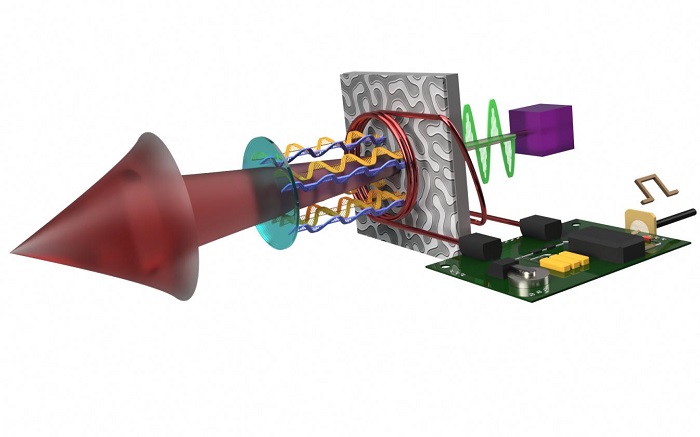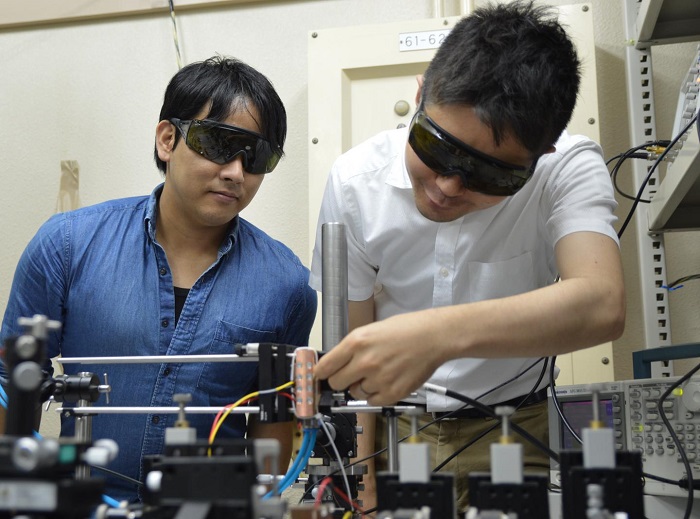27-JUL-2016
The "Industry 4.0" concept, first introduced by the German government, has recently extended the scope of compact high-power laser applications to, for instance, laser manufacturing, vehicle engine development, or thruster systems for space exploration.
However, integration of a controllable Q-switch into compact solid-state lasers has been challenging because of the mechanisms of EO and AO effects. In addition, previous Q-switches needed a large-sized power supply, which prevented downscaling of the entire system.
Now, researchers at Toyohashi University of Technology, Iowa State University, and the Institute for Molecular Science have developed a magneto-optic (MO) Q-switched laser for the first time, using a 190-micron-thick magnetic garnet film with labyrinth-shaped magnetic domains. They used custom-made coil and circuits to generate the pulsed magnetic field to be applied to the magnetic garnet, and successfully generated optical output with a pulse width of tens of nanoseconds. This is the first demonstration ever of a Q-switched laser driven by magnetic domain motions, and also the first evidence of the possibility of an integrated Q-switched laser. "The device was two orders of magnitude smaller than other reported controllable Q-switches," commented Associate Professor Taira.
"The most difficult part of realizing MO Q-switching was to combine three different techniques/fields: the preparation of a magnetic material, the fabrication of a high-speed magnetic field switch, and the construction of a laser cavity," explained PhD candidate Ryohei Morimoto.

A pulsed output with a power of dozens of watts and a pulse width of 40 ns was obtained through an MO Q-switched laser controlled by labyrinth-shaped magnetic domains.
CREDIT:
COPYRIGHT (C) TOYOHASHI UNIVERSITY OF TECHNOLOGY. ALL RIGHTS RESERVED.
According to the first author, Assistant Professor Taichi Goto, "there are no previous reports of MO Q-switches using thin garnets. This is surely the first demonstration, and it also becomes an important first step in the development of an integrated high-power laser."
"We enjoy our collaboration and learn from each other," said Professor Mina Mani. "We further hope not only to advance research and create and pursue new challenges, but also to use science and technology to make a better world for all."
In addition, the researchers found a unique biasing technique that uses magnetism to decrease the electric power needed for Q-switching. When a ring-shaped permanent magnet was placed close to the magnetic garnet, they were able to generate the same optical pulse in the MO Q-switched laser using seven times less electric power. This result showed that this Q-switch does not need a large power supply for operation, meaning that drastic downscaling can be expected. The research team would like their future studies to be useful for laser users all around the world and to help in the establishment of new industries.
###
We acknowledge support from the following institutions:
- Japan Society for the Promotion of Science (JSPS) KAKENHI Nos. 26706009, 26600043, 26220902, 25820124, and 15H02240.
- Japan Science and Technology Agency (JST) - Promoting individual research to nurture the seeds of future innovation and organizing unique, innovative network (PRESTO).
Reference:
T. Goto, R. Morimoto, J. W. Pritchard, M. Mina, H. Takagi, Y. Nakamura, P. B. Lim, T. Taira, and M. Inoue, (2016)."Magneto-optical Q-switching using magnetic garnet film with micromagnetic domains," Opt. Express, 24, (16), 17635-17643. DOI: 10.1364/OE.24.017635.














